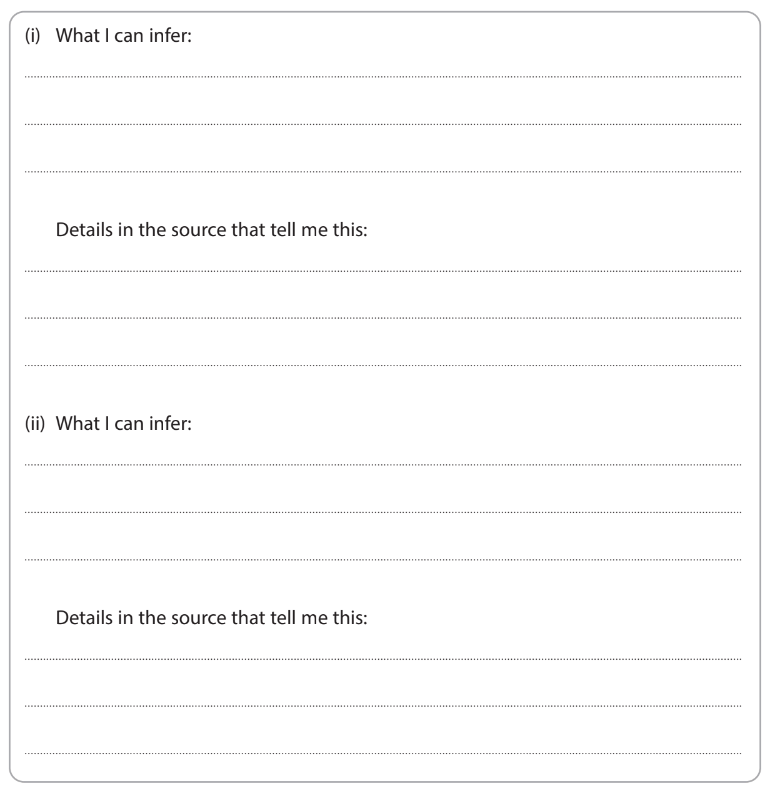The 4 Mark "Give Two Things You Can Infer" Question (Edexcel GCSE History): Revision Note
Exam code: 1HI0
Summary of Question 1
Question 1 requires you to make two inferences about Source A
Each inference must be directly supported by a detail or quote from the source
The answer section is broken down into four guided questions
Amount of marks | 4 |
|---|---|
The time that you should spend on the question | No more than 5 minutes |
An example of the type of question you may encounter can be seen below:

In previous years, this question has focused on the following topics in Weimar and Nazi Germany:
Year of Exam | Question Topic |
|---|---|
2018 | The success of the Berlin Olympic Games in 1936 (opens in a new tab) |
2019 | The early development of the Nazi Party (opens in a new tab) |
2020 | The treatment of the Jewish people during 'Kristallnacht' (opens in a new tab) |
2021 | How the Nazis reacted to the Reichstag Fire (opens in a new tab) |
2022 | The Hitler Youth (opens in a new tab) |
2023 | Education in Nazi Germany (opens in a new tab) |
2024 | How Hitler increased support for the Nazi Party in the early 1920s |
What is an inference?
An inference is an educated guess based on evidence
To remember how to infer, follow these steps:
I notice — What does the source show or say?
I already know — What own knowledge do you have?
Now I am thinking … — Combine the above to make your inference
For the Weimar and Nazi Germany exam, you will need to:
Study Source A
Utilise your own knowledge to make sense of the source
Make a statement about Source A, connecting what you can see and what you know
Using the content of a source
The content is the information presented in the source
The content could come from a variety of different types of sources such as:
A picture
A photograph
An extract from a book
A speech
A political cartoon
A letter
You should use details from the content (a quote or description) to support each inference
In the example question, you should look at Source A for information about life in Germany under the Nazis
How to answer a "Give two things you can infer" question
Question 1 will always be based on Source A
You will find Source A on the first page of the answer booklet
Do not use the sources in the insert booklet
Sources B and C are clearly marked for Section B of the paper

To begin, read the question carefully
Underline the topic mentioned in the question
Read the source, in full, several times
If Source A is a visual source, take your time to study the source
Annotate the source by applying knowledge to the source that is relevant to the question
"Give two things you can infer" question structure
The 'Give two things you can infer' answer space is laid out clearly into four guided sections

Section | What to write |
|---|---|
"What I can infer" | Your first inference (1) |
"Details in the source that tell me this" | A quote (for a written source) or a description (for a visual source) (1) |
"What I can infer" | Your second inference, different from your first inference (1) |
"Details in the source that tell me this" | A different quote or a description (1) |
You will be limited to 2 marks if you:
Only write inferences
Only select details from the source
Write more than two inferences
Do not back your inferences with details from Source A
Worked example of a "Give two things you can infer" question
Worked Example
Give two things you can infer from Source A about life in Germany under the Nazis.
Complete the table below to explain your answer.

(4)
Answer
What I can infer: It was dangerous to voice your opinion in Nazi Germany. (1)
Details in the source that tell me this: 'The remark was overheard and five minutes later the woman was arrested by the Gestapo.' (1)
What I can infer: People reported incidents of disloyalty to the Nazis to the Gestapo. (1)
Details in the source that tell me this: 'the Gestapo, who had been alerted by telephone.' (1)

Unlock more, it's free!
Did this page help you?